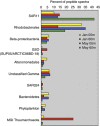Metaproteomic analysis of a winter to spring succession in coastal northwest Atlantic Ocean microbial plankton
- PMID: 24401863
- PMCID: PMC4030229
- DOI: 10.1038/ismej.2013.234
Metaproteomic analysis of a winter to spring succession in coastal northwest Atlantic Ocean microbial plankton
Abstract
In this study, we used comparative metaproteomics to investigate the metabolic activity of microbial plankton inhabiting a seasonally hypoxic basin in the Northwest Atlantic Ocean (Bedford Basin). From winter to spring, we observed a seasonal increase in high-affinity membrane transport proteins involved in scavenging of organic substrates; Rhodobacterales transporters were strongly associated with the spring phytoplankton bloom, whereas SAR11 transporters were abundant in the underlying waters. A diverse array of transporters for organic compounds were similar to the SAR324 clade, revealing an active heterotrophic lifestyle in coastal waters. Proteins involved in methanol oxidation (from the OM43 clade) and carbon monoxide (from a wide variety of bacteria) were identified throughout Bedford Basin. Metabolic niche partitioning between the SUP05 and ARCTIC96BD-19 clades, which together comprise the Gamma-proteobacterial sulfur oxidizers group was apparent. ARCTIC96BD-19 proteins involved in the transport of organic compounds indicated that in productive coastal waters this lineage tends toward a heterotrophic metabolism. In contrast, the identification of sulfur oxidation proteins from SUP05 indicated the use of reduced sulfur as an energy source in hypoxic bottom water. We identified an abundance of Marine Group I Thaumarchaeota proteins in the hypoxic deep layer, including proteins for nitrification and carbon fixation. No transporters for organic compounds were detected among the thaumarchaeal proteins, suggesting a reliance on autotrophic carbon assimilation. In summary, our analyses revealed the spatiotemporal structure of numerous metabolic activities in the coastal ocean that are central to carbon, nitrogen and sulfur cycling in the sea.
Figures





Similar articles
-
A metaproteomic assessment of winter and summer bacterioplankton from Antarctic Peninsula coastal surface waters.ISME J. 2012 Oct;6(10):1883-900. doi: 10.1038/ismej.2012.28. Epub 2012 Apr 26. ISME J. 2012. PMID: 22534610 Free PMC article.
-
Urea uptake and carbon fixation by marine pelagic bacteria and archaea during the Arctic summer and winter seasons.Appl Environ Microbiol. 2014 Oct;80(19):6013-22. doi: 10.1128/AEM.01431-14. Epub 2014 Jul 25. Appl Environ Microbiol. 2014. PMID: 25063662 Free PMC article.
-
Heterotrophic carbon metabolism and energy acquisition in Candidatus Thioglobus singularis strain PS1, a member of the SUP05 clade of marine Gammaproteobacteria.Environ Microbiol. 2019 Jul;21(7):2391-2401. doi: 10.1111/1462-2920.14623. Epub 2019 Apr 24. Environ Microbiol. 2019. PMID: 30951247
-
Master recyclers: features and functions of bacteria associated with phytoplankton blooms.Nat Rev Microbiol. 2014 Oct;12(10):686-98. doi: 10.1038/nrmicro3326. Epub 2014 Aug 19. Nat Rev Microbiol. 2014. PMID: 25134618 Review.
-
Microbial metabolites in the marine carbon cycle.Nat Microbiol. 2022 Apr;7(4):508-523. doi: 10.1038/s41564-022-01090-3. Epub 2022 Apr 1. Nat Microbiol. 2022. PMID: 35365785 Review.
Cited by
-
Metaproteomics reveal that rapid perturbations in organic matter prioritize functional restructuring over taxonomy in western Arctic Ocean microbiomes.ISME J. 2020 Jan;14(1):39-52. doi: 10.1038/s41396-019-0503-z. Epub 2019 Sep 6. ISME J. 2020. PMID: 31492961 Free PMC article.
-
Metaexoproteomics Reveals Microbial Behavior in the Ocean's Interior.Front Microbiol. 2022 Feb 16;13:749874. doi: 10.3389/fmicb.2022.749874. eCollection 2022. Front Microbiol. 2022. PMID: 35250917 Free PMC article.
-
A Metaproteomic Analysis of the Response of a Freshwater Microbial Community under Nutrient Enrichment.Front Microbiol. 2016 Aug 3;7:1172. doi: 10.3389/fmicb.2016.01172. eCollection 2016. Front Microbiol. 2016. PMID: 27536273 Free PMC article.
-
Microbial Surface Colonization and Biofilm Development in Marine Environments.Microbiol Mol Biol Rev. 2015 Dec 23;80(1):91-138. doi: 10.1128/MMBR.00037-15. Print 2016 Mar. Microbiol Mol Biol Rev. 2015. PMID: 26700108 Free PMC article. Review.
-
A decade of metaproteomics: where we stand and what the future holds.Proteomics. 2015 Oct;15(20):3409-17. doi: 10.1002/pmic.201500183. Epub 2015 Sep 10. Proteomics. 2015. PMID: 26315987 Free PMC article.
References
-
- Baker GC, Smith JJ, Cowan DA. Review and re-analysis of domain-specific 16S primers. J Microbiol Methods. 2003;55:541–555. - PubMed
-
- Béjà O, Aravind L, Koonin EV, Suzuki MT, Hadd A, Nguyen LP, et al. Bacterial rhodopsin: evidence for a new type of phototrophy in the sea. Science. 2000;289:1902–1906. - PubMed
-
- Béjà O, Suzuki MT, Heidelberg JF, Nelson WC, Preston CM, Hamada T, et al. Unsuspected diversity among marine aerobic anoxygenic phototrophs. Nature. 2002;415:630–633. - PubMed
Publication types
MeSH terms
Substances
LinkOut - more resources
Full Text Sources
Other Literature Sources

